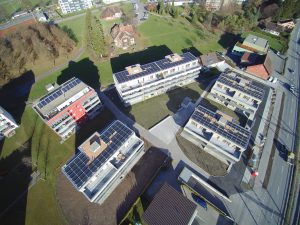
A community in Switzerland has completed a successful year-long trial of a blockchain electricity market, a technology being eyed for community microgrids.

Walenstadt, Switzerland. Courtesy of Quartierstrom
The Swiss Federal Office of Energy (SFOE) funded project Quartierstrom, the first of its kind in the world, involving 37 households in Walenstadt, Switzerland. For one year, the community traded locally produced power.
The 37 households covered 33% of their electricity demand with solar power produced by the households with installed solar PV, twice as much as before the trial.
Producers of solar power set their preferred minimum price, and consumers set the maximum price they were willing to pay via a portal.
A mini computer with a built-in electricity meter and blockchain software, installed at each household, processed the resulting transactions.
The mini computers acted as nodes in the blockchain system and placed bids into an auction for the purchase or sale of solar power every 15 minutes.
Surprising level of engagement
The local utility, Water and Electricity Works Walenstadt (WEW), bought any surplus generation from the participants, and supplied additional power if local generation couldn’t meet the demand.
Participants were generally positive about their experience, and project partners were surprised by the level of engagement.
“For most people at the end of a long working day, accessing a web application of a utility company is not their first priority to spend their free time,” Verena Tiefenbeck, leader of the Bits to Energy Lab at ETH Zurich, who were the main co-ordinators of the project, told Microgrid Knowledge.
“We were really surprised how often the participants logged in and monitored what’s going on in the system and how often they changed prices.”
The blockchain system acted as an accounting ledger, distributed between the participants.
“It’s a system where you can store information that cannot be tampered with, and you can add new information, and as long as the majority of participants in the system agree that this is the correct information,” Tiefenbeck said.
Lower energy demand blockchain system
Blockchain systems can be energy-intensive because every participating computer or ‘validating node’ involved must carry out complex calculations.
“We had a restricted system, only the households who owned PV panels did those computations. If you have a limited number of ‘validating nodes’ that have to agree between themselves on what is true information, then it’s less computationally intensive and as a consequence it uses less energy,” Tiefenbeck explained.
There are proposals for a follow up project, with a larger number of participants, different smart meters, and development of smarter algorithms.
“It was interesting to see people setting prices manually and so on but the idea is to now have a system where we develop some agent that actually learns participants’ preferences and takes decisions on their behalf,” Tiefenbeck said.
In the US, a microgrid using blockchain is under development in Brooklyn, New York. And in Vermont, Green Mountain Power has launched a program that allows homeowners to sell renewable energy directly to businesses served by the utility. Both projects are being developed by LO3 Energy, a company with backing from Siemens and several other major investors.
In addition, Schneider Electric and software company Arensis have teamed up to develop smart microgrids using blockchain to help those in remote areas of the world make electricity transactions.
This article was originally published on Microgrid Knowledge. Republished here with permission.


